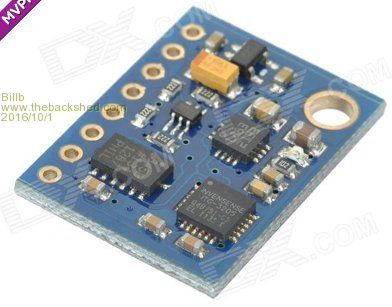
|

|
Forum Index : Microcontroller and PC projects : accelerometers
| Author | Message | ||||
| MOBI Guru Joined: 02/12/2012 Location: AustraliaPosts: 819 |
Hi all, I've been trying to get a INVENSENSE MPU6050 accelerometer working with a MaxiMite. I can read the chip ID (register 117) correctly, but am at a loss to successfully read any other register (or what makes sense). I would like to start with the temperature registers 65 and 66. Has anyone on the forum played with these things? Is there a specific "start-up" procedure? Starting to go cross eyed reading a lot of fine print. David M. |
||||
| MOBI Guru Joined: 02/12/2012 Location: AustraliaPosts: 819 |
G'day again, After a bit more hair pulling (yes, I still have a little left)and experimenting, I found a power management register (107) with bit 6 as SLEEP bit. This was set to '1' which meant that the device was in sleep mode. I cleared the register and suddenly had access to the 16 bit temperature register pair 65 and 66. Putting my finger on the chip caused the temperature count to increase and removing, the temp went down. Looks promising. Actually, Downwind fed me the data sheets a couple of months ago citing a problem of not enough hair left to pull out. I don't know where this will lead but it might be of use for someone. Now to play with the x,y,z axes. David M. |
||||
| BobD Guru Joined: 07/12/2011 Location: AustraliaPosts: 935 |
David You have me curious. I just Googled for the MPU6050 and I see Sparkfun selling at $40 and Banggood at $4 for what appear to be very similar items. What are you going to do with it? Bob |
||||
| MOBI Guru Joined: 02/12/2012 Location: AustraliaPosts: 819 |
@ Bob I got a couple of modules from Modtronix (Sydney) - I thought they were about $10 each on a small PCB about 20mm x 15mm You can get them out of china for much less. I don't know what to do with it yet as it wasn't my project, I was just the bunny asked to see if I could get it going. I think Downwind spent a couple of dollars for the same thing. I bought a few other items at the time and got free postage. Delivery was a couple of days instead of the 3 weeks out of china. Since I got the in-chip temperature sensor working, also the rotational axes work. Maybe some one can find a use - perhaps one of the GPS gurus? Uses could include camera stabilizing, quadcopter balance, vibration analysis??? David M. |
||||
| BobD Guru Joined: 07/12/2011 Location: AustraliaPosts: 935 |
Thanks, it's amazing what can be packed into a chip. I often wonder how they construct gyros and accelerometers inside these chips. |
||||
| MOBI Guru Joined: 02/12/2012 Location: AustraliaPosts: 819 |
In my RAN days, I used to maintain (among many technologies) Gyro compasses. These had a heavy steel wheel about 15 inches in diameter running at high speed with E-type pickups, mercury pots etc. The units stood about 3 feet high. I'd love to see them stick one of those in a 3mm chip.!! Must ask google how the solid state devices work. Strain gauges, magnetic or what? David M. |
||||
palcal Guru Joined: 12/10/2011 Location: AustraliaPosts: 2027 |
Back in Aug. 2011 Silicon Chip described a Digital Spirit Level using an MMA8451Q 3 axis 16 pin QFN device. I constructed the project and I must say the device was almost impossible to solder. The spirit level performs extremely well with a resolution of 0.1 degree. Then in Nov. 2011 they described a G-Force Meter using the same chip. The article describes the operation of the chip and it is very interesting. Apparently each axis has a transducer which is a microscopic sprung mass forming the moving plate of a capacitor. Paul. Edit. A bit hard to get my head around a 3mm chip with 3 moving parts inside. "It is better to be ignorant and ask a stupid question than to be plain Stupid and not ask at all" |
||||
| MOBI Guru Joined: 02/12/2012 Location: AustraliaPosts: 819 |
@palcal I had a read through some web pages on the 6050 devices (didn't note them down - but are easy to find). 3 microscopic transducers in a 3mm chip is not that mind boggling when you consider what goes into say a PIC32. The operation is not that difficult to understand either. Force = mass x acceleration. If we know the mass hanging off the capacitor and can measure the force as a function of variable capacitance, then acceleration is a simple conversion: Acceleration = force/mass. Too easy. The 6050 does the calculation so it is even easier for the constructor. I like the idea of a micromite driven spirit level. Might give it a go. A relatively expensive spirit level but what the heck? Anybody else have any suggestions? David M. |
||||
| paceman Guru Joined: 07/10/2011 Location: AustraliaPosts: 1329 |
I had a quick look at those articles Paul and they didn't give much info about how they make the moving capacitor. I'm not sure if the MMA8451Q does it this way but a lot of MEMS accelerometer devices (Micro Electro Mechanical Systems) produce the "sprung mass" by similar multi-layer photo-etching processes used to etch the silicon for purely electrical devices. The "mechanical" difference is that a section of the silicon is left suspended in "mid air" (actually enclosed) like a cantilevered beam, above a bigger etched pit. For each axis there's a separate beam/pit aligned 90 degrees to the others. To change sensitivity the thickness of the "beam" can be as fine or thick as they need and the size of the part left at its end, (that provides both the mass and one side of the capacitor) can also be changed. To stop the mass moving too far and breaking the beam (silicon is very brittle) the etching is arranged to also leave a solid "stop" within the fully elastic range. Silicon etches at different rates in different crystallographic directions so it's important that when they do it they align the base silicon carefully and have very tight control over the etching process. I guess that's a requirement of most high density chips these days so they're used to it! I've spent some time looking at etch pits with scanning electron microscopes and it's amazing how sharp and directional they can be. Greg |
||||
| Lightrock Newbie Joined: 19/05/2014 Location: AustraliaPosts: 26 |
Altronics stock an MPU-6050 module (Z6324) for $19.95. |
||||
Downwind Guru Joined: 09/09/2009 Location: AustraliaPosts: 2333 |
I paid around $2.50 each including postage fully mounted on a PCB with on board Vreg etc, ready to plug and play from China off ebay. I would wait the 2 weeks for delivery from China rather than pay $20.00 each at a local price. Pete. Sometimes it just works |
||||
Herry Senior Member Joined: 31/05/2014 Location: AustraliaPosts: 261 |
I am thinking of using an accelerometer to gauge vibration from worn bearings. Any comments? Senior?! Whatever it says, I'm a complete and utter beginner... |
||||
Bill.b Senior Member Joined: 25/06/2011 Location: AustraliaPosts: 244 |
@BobD This little beast contains a Compass, accelerometer and a Gyro all in a package 2.2cm * 1.6. GY-85, Comms are I2C and is from DX.com for $11.00 Au I have used this it with picaxe so would work with pic32s OK.  Bill In the interests of the environment, this post has been constructed entirely from recycled electrons. |
||||
TassyJim Guru Joined: 07/08/2011 Location: AustraliaPosts: 6399 |
It is easy to get data with the 'mites but I think you will want reasonably high frequency which can be a problem. You might be able to record a burst of data then process and display it after the event rather than trying for realtime display. We use to use accelerometers to balance 20+ MW turbines but they were only running at 600rpm. You could get a good feel for the balance by taking your boot off and standing on the edge of the checkerplates. Jim VK7JH MMedit |
||||
Herry Senior Member Joined: 31/05/2014 Location: AustraliaPosts: 261 |
Hi Jim Thanks for response. What prompted this was me changing the front bearings in my classic Jaguar XJ40, which was moaning (not me or the wife...). The old bearings were so worn (needle taper) that at hand speed they grated. So the testing speed would be quite low and I feel an accelerometer should be able to detect the difference between a good and bad bearing at very slow speed, say 60 rpm (under sideways pressure). So far one problem seems to be the inherent vibration in the testing motor bearings! Senior?! Whatever it says, I'm a complete and utter beginner... |
||||
TassyJim Guru Joined: 07/08/2011 Location: AustraliaPosts: 6399 |
A smart phone would be worth trying if you have somewhere to mount it. Mounting will be an issue for whatever you use. I guess I am lucky, I don't need any sophisticated test gear to know that a CV joint on my MG is stuffed. I was lucky to get it home without the wheel falling of. My problem is waiting until the CV joint in my shoulder is good enough for me to do any physical work. Hopefully before another bit of me falls apart. Jim VK7JH MMedit |
||||
Herry Senior Member Joined: 31/05/2014 Location: AustraliaPosts: 261 |
Jim. Like most mechanical parts you must lubricate it regularly. A swift red might help (after the repair job and not before it I find I always torque to myself if I forget that). Senior?! Whatever it says, I'm a complete and utter beginner... |
||||
| The Back Shed's forum code is written, and hosted, in Australia. | © JAQ Software 2025 |